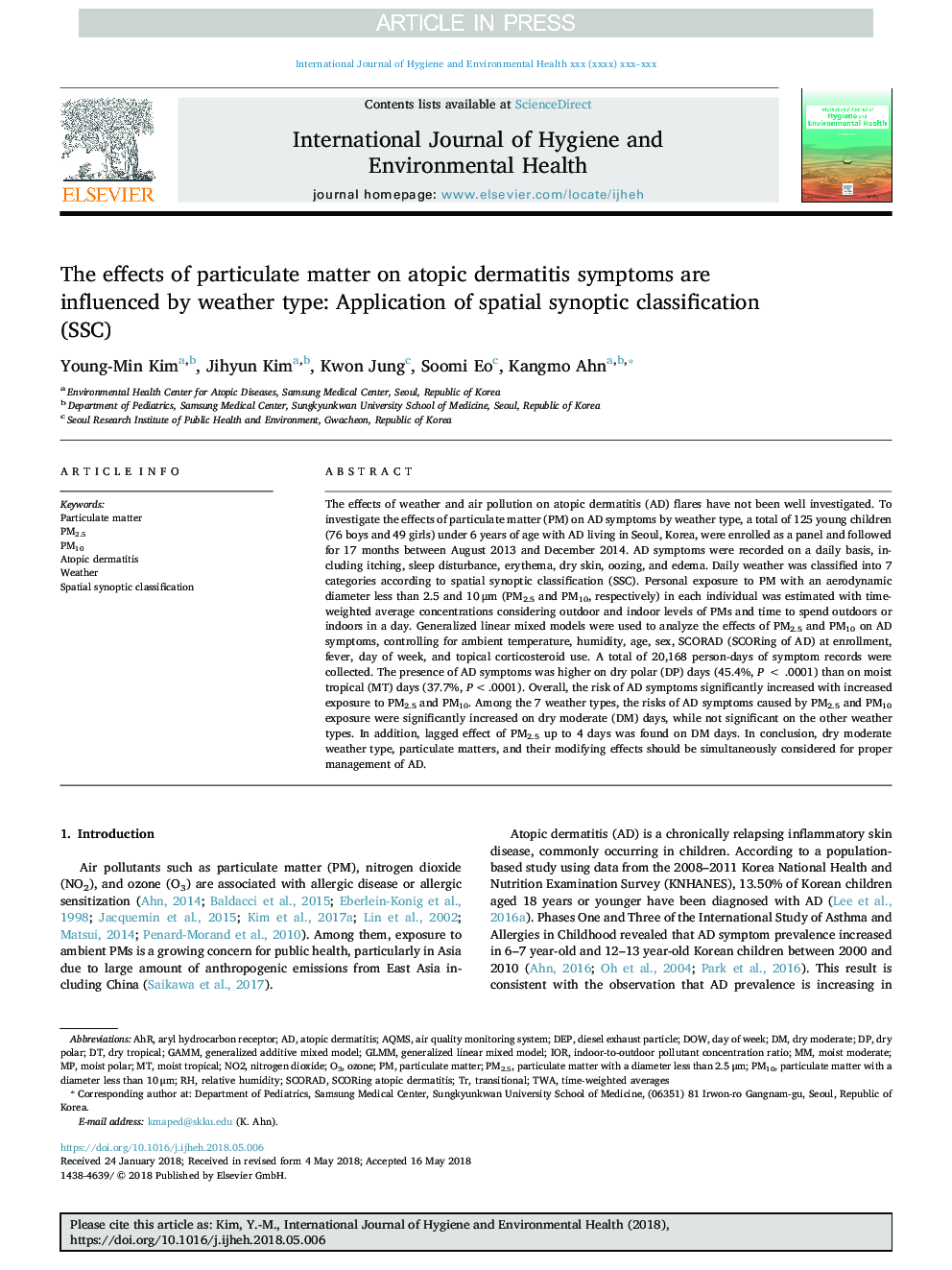| کد مقاله | کد نشریه | سال انتشار | مقاله انگلیسی | نسخه تمام متن |
|---|---|---|---|---|
| 8549549 | 1561864 | 2018 | 7 صفحه PDF | دانلود رایگان |
عنوان انگلیسی مقاله ISI
The effects of particulate matter on atopic dermatitis symptoms are influenced by weather type: Application of spatial synoptic classification (SSC)
دانلود مقاله + سفارش ترجمه
دانلود مقاله ISI انگلیسی
رایگان برای ایرانیان
کلمات کلیدی
AHRGLMMTWASCORADGAMMDEPIORPM10AQMSPM2.5Weather - آب و هوا Ozone - اُزون Atopic dermatitis - درماتیت آتوپیکScoring Atopic Dermatitis - درماتیت آتوپیک نمره دهی می شودdow - دووdiesel exhaust particle - دیزل اگزوز ذراتparticulate matter - ذرات معلقRelative humidity - رطوبت نسبیDay of week - روز هفتهSpatial synoptic classification - طبقه بندی سم شناسی فضاییGeneralized Additive Mixed Model - مدل ترکیبی افزایشی عمومیGeneralized linear mixed model - مدل ترکیبی خطی متداولNitrogen dioxide - نیتروژن دیاکسیدNO2 - نیتروژن دیاکسیدTransitional - گذارaryl hydrocarbon receptor - گیرنده آرویل هیدروکربن
موضوعات مرتبط
علوم زیستی و بیوفناوری
علوم محیط زیست
بهداشت، سم شناسی و جهش زایی
پیش نمایش صفحه اول مقاله

چکیده انگلیسی
The effects of weather and air pollution on atopic dermatitis (AD) flares have not been well investigated. To investigate the effects of particulate matter (PM) on AD symptoms by weather type, a total of 125 young children (76 boys and 49 girls) under 6 years of age with AD living in Seoul, Korea, were enrolled as a panel and followed for 17 months between August 2013 and December 2014. AD symptoms were recorded on a daily basis, including itching, sleep disturbance, erythema, dry skin, oozing, and edema. Daily weather was classified into 7 categories according to spatial synoptic classification (SSC). Personal exposure to PM with an aerodynamic diameter less than 2.5 and 10â¯Î¼m (PM2.5 and PM10, respectively) in each individual was estimated with time-weighted average concentrations considering outdoor and indoor levels of PMs and time to spend outdoors or indoors in a day. Generalized linear mixed models were used to analyze the effects of PM2.5 and PM10 on AD symptoms, controlling for ambient temperature, humidity, age, sex, SCORAD (SCORing of AD) at enrollment, fever, day of week, and topical corticosteroid use. A total of 20,168 person-days of symptom records were collected. The presence of AD symptoms was higher on dry polar (DP) days (45.4%, Pâ¯<â¯.0001) than on moist tropical (MT) days (37.7%, P < .0001). Overall, the risk of AD symptoms significantly increased with increased exposure to PM2.5 and PM10. Among the 7 weather types, the risks of AD symptoms caused by PM2.5 and PM10 exposure were significantly increased on dry moderate (DM) days, while not significant on the other weather types. In addition, lagged effect of PM2.5 up to 4 days was found on DM days. In conclusion, dry moderate weather type, particulate matters, and their modifying effects should be simultaneously considered for proper management of AD.
ناشر
Database: Elsevier - ScienceDirect (ساینس دایرکت)
Journal: International Journal of Hygiene and Environmental Health - Volume 221, Issue 5, June 2018, Pages 823-829
Journal: International Journal of Hygiene and Environmental Health - Volume 221, Issue 5, June 2018, Pages 823-829
نویسندگان
Young-Min Kim, Jihyun Kim, Kwon Jung, Soomi Eo, Kangmo Ahn,